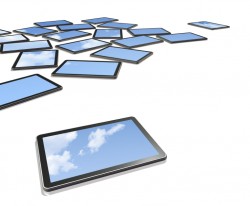19th Mar. '11
 Especially with the iPad 2 coming out, many are wondering if the iPad is a full replacement for the laptop. And if not, what is it? And what are the consequences for the IT organization?
Especially with the iPad 2 coming out, many are wondering if the iPad is a full replacement for the laptop. And if not, what is it? And what are the consequences for the IT organization?
Will devices only be used to consume information? Likely some form of input will be necessary. From not talking to quick communication via email or Facebook updates or Twitter. There will still be a need for “specialized” devices or extensions for devices, like a keyboard for the writers of long texts or designers of complex graphics.
But the vast majority of our communication will be short and succinct and many of the input mechanisms of the latest mobile devices are already fully sufficient.
As the amount of information and tasks we try to squeeze into a device; screen size will be a factor for the usability. On the other hand, it is the weight and the size that impact mobility.
The “new devices” are not “replacing” the PC, but often fulfill specialist functions that in the past a PC would not have been used for. Anybody carrying a 2 kg laptop as a phone?
But because now these devices can also do some of what only PCs could do in the past, the need for PCs is decreasing. Not going away, but decreasing.
Like with Social Networks (or the PCs for that matter) we discover (usually the Digital Cowboys discover it first) what other functions the devices can perform. And the newly discovered uses go often far beyond what the original invention or design was intended for.
Like with the IT capabilities of an organization; it is important to look at the capabilities and functions the end-user device is performing.
Lets look at the iPad from Apple as an example. Looking at some of the functions it performs, its functional “capabilities” (or use), and how it compares.
- Mobility: More mobile than a laptop, but less than a phone
- Weight: lighter than a PC
- Screen size (usability): more than a phone but less than a laptop and far less than a flat-screen TV
- Note taking: nearly as easy to use as paper, but far easier to share and further use of the notes
- Data access: near universal, similar to PC and phone also in speed. But less manageability and security than a managed PC
- Entertainment: better video than phone, but inferior to TV; heavier than iPod for music
- Reading: inferior to Amazon’s Kindle or printed documents in readability and battery life but color
- Pictures: similar quality to phones (not as easy to handle); inferior to actual digital cameras.
While it is easy to find a better solution or device for a specific capability, for the user the iPad doesn’t compete with their TV or PC. It simply adds opportunities, e.g. to watch a movie when on the road, to have a video conference when sitting in the park and to read a magazine while reviewing pictures from a photo shoot.
There are large organizations that are exploring to replace at least some significant percentage of their laptop population with iPads or other slate devices.
But will the iPad replace all the other devices, including the laptops? Surely not. But it adds capabilities to situations where we didn’t have them before and opens new usage scenarios that have an impact on the “traditional” devices and solutions delivering a capability “traditionally”.
Will any device in the future be the “one fits all”? Highly unlikely in the next decade. Maybe when we achieve Singularity and have a device directly implanted in our brains…
Comments:
